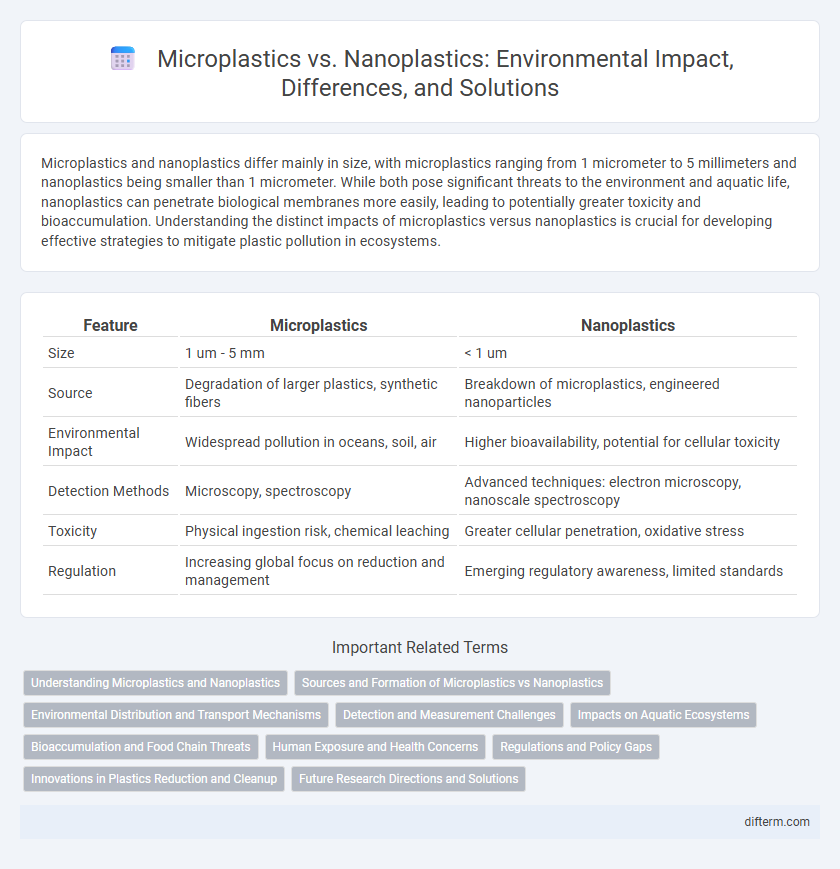Microplastics and nanoplastics differ mainly in size, with microplastics ranging from 1 micrometer to 5 millimeters and nanoplastics being smaller than 1 micrometer. While both pose significant threats to the environment and aquatic life, nanoplastics can penetrate biological membranes more easily, leading to potentially greater toxicity and bioaccumulation. Understanding the distinct impacts of microplastics versus nanoplastics is crucial for developing effective strategies to mitigate plastic pollution in ecosystems.
Table of Comparison
| Feature | Microplastics | Nanoplastics |
|---|---|---|
| Size | 1 um - 5 mm | < 1 um |
| Source | Degradation of larger plastics, synthetic fibers | Breakdown of microplastics, engineered nanoparticles |
| Environmental Impact | Widespread pollution in oceans, soil, air | Higher bioavailability, potential for cellular toxicity |
| Detection Methods | Microscopy, spectroscopy | Advanced techniques: electron microscopy, nanoscale spectroscopy |
| Toxicity | Physical ingestion risk, chemical leaching | Greater cellular penetration, oxidative stress |
| Regulation | Increasing global focus on reduction and management | Emerging regulatory awareness, limited standards |
Understanding Microplastics and Nanoplastics
Microplastics are plastic particles smaller than 5 millimeters, often originating from larger plastic debris breakdown, while nanoplastics measure less than 100 nanometers, posing greater risks due to their ability to penetrate biological barriers. Both microplastics and nanoplastics contaminate aquatic ecosystems, soil, and air, but nanoplastics have a higher potential for cellular uptake and toxicity in organisms. Understanding their sources, distribution, and environmental fate is crucial for assessing impacts on biodiversity and human health.
Sources and Formation of Microplastics vs Nanoplastics
Microplastics primarily originate from the breakdown of larger plastic debris like packaging, synthetic textiles, and personal care products, whereas nanoplastics form through further degradation processes involving mechanical, chemical, and biological factors that reduce microplastics into nanoparticle-sized fragments. Common sources of microplastics include tire wear particles, microbeads in cosmetics, and industrial abrasives, while nanoplastics emerge from environmental weathering, UV radiation, and microbial activity acting on microplastic particles. Understanding these distinct sources and formation pathways is crucial for assessing the environmental distribution and potential toxicity of microplastics versus nanoplastics.
Environmental Distribution and Transport Mechanisms
Microplastics and nanoplastics exhibit distinct environmental distribution patterns driven by their size and physicochemical properties, affecting their transport mechanisms through aquatic, atmospheric, and terrestrial systems. Microplastics predominantly accumulate in sediments and surface waters due to buoyancy and particle aggregation, while nanoplastics can penetrate deeper environmental compartments and biofilms owing to their smaller size and higher reactivity. Transport mechanisms for nanoplastics include diffusion, Brownian motion, and cellular uptake, enabling widespread dispersal and potential bioaccumulation across multiple trophic levels, whereas microplastic movement is largely influenced by hydrodynamic forces and sediment resuspension.
Detection and Measurement Challenges
Detecting microplastics and nanoplastics in environmental samples presents significant analytical challenges due to their diverse sizes, shapes, and chemical compositions. Advanced techniques such as Raman spectroscopy, Fourier-transform infrared spectroscopy (FTIR), and electron microscopy are essential for precise identification but require specialized equipment and expertise. Accurate quantification is further complicated by contamination risks and the lack of standardized protocols, hindering reliable comparative studies.
Impacts on Aquatic Ecosystems
Microplastics and nanoplastics disrupt aquatic ecosystems by damaging marine biodiversity and altering food webs. Nanoplastics pose greater risks due to their smaller size, enabling deeper penetration into tissues and more severe toxic effects on aquatic organisms. These particles contribute to habitat degradation, bioaccumulation, and increased mortality rates, threatening the stability of aquatic environments.
Bioaccumulation and Food Chain Threats
Microplastics and nanoplastics differ significantly in their bioaccumulation patterns, with nanoplastics exhibiting higher cellular penetration and persistence in aquatic organisms. These particles disrupt the food chain by transferring toxic substances through trophic levels, amplifying ecological and human health risks. Research shows nanoplastics' smaller size leads to greater bioavailability, increasing the potential for biomagnification in marine ecosystems.
Human Exposure and Health Concerns
Human exposure to microplastics and nanoplastics occurs primarily through ingestion, inhalation, and dermal contact, with nanoplastics posing higher health risks due to their smaller size and greater ability to penetrate biological tissues. Studies indicate nanoplastics can cross cell membranes, potentially causing oxidative stress, inflammation, and cellular toxicity, raising concerns about long-term impacts on the immune, respiratory, and digestive systems. The persistence of these plastics in the human body underscores urgent need for research on their bioaccumulation and associated chronic diseases.
Regulations and Policy Gaps
Current regulations inadequately address the unique risks posed by microplastics and nanoplastics, leading to significant policy gaps in environmental protection frameworks. Most existing legislation targets larger plastic debris, neglecting the smaller scale particles that penetrate ecosystems and human health more deeply. Strengthening regulatory standards to specifically monitor, control, and mitigate nanoplastic pollution is critical for effective environmental management and future policy development.
Innovations in Plastics Reduction and Cleanup
Emerging technologies in plastics reduction focus on advanced filtration systems capable of capturing microplastics down to the nanoscale, significantly minimizing environmental contamination. Innovations such as enzymatic degradation and biodegradable nanocomposites accelerate the breakdown of persistent nanoplastics in aquatic ecosystems. Research into magnetic nanoparticles offers promising cleanup methods by binding nanoplastics for efficient removal from wastewater and marine environments.
Future Research Directions and Solutions
Future research on microplastics and nanoplastics must prioritize developing innovative detection technologies capable of identifying particles at the nanoscale to understand their environmental distribution and toxicity more accurately. Investigating the long-term ecological and human health impacts of these plastics will drive the creation of effective bioremediation and filtration methods tailored to different ecosystems. Collaborative efforts integrating material science, environmental chemistry, and policy development are essential to devise sustainable solutions aiming to reduce plastic pollution and its nano-sized derivatives.
microplastics vs nanoplastics Infographic

 difterm.com
difterm.com